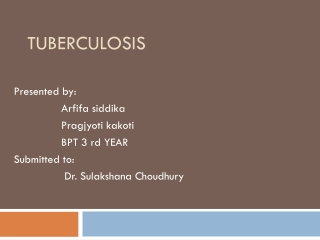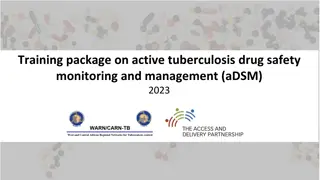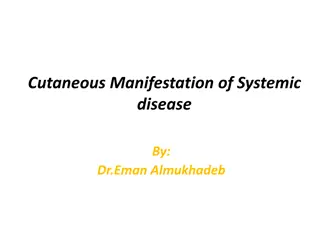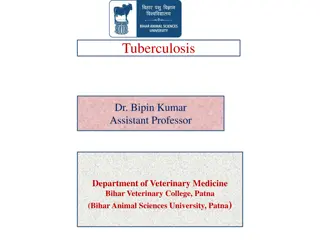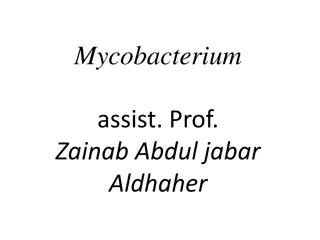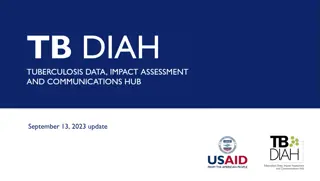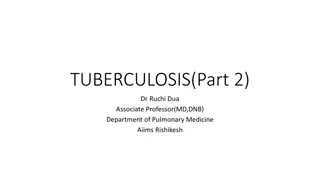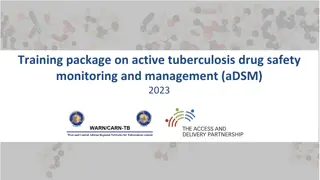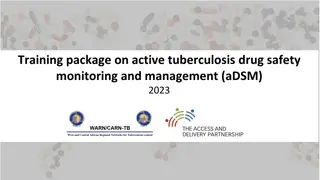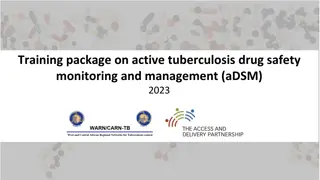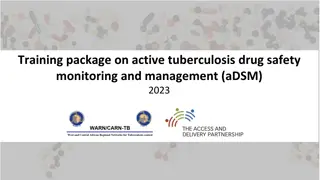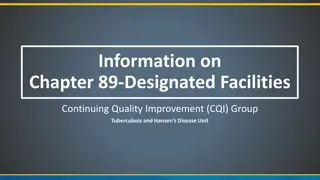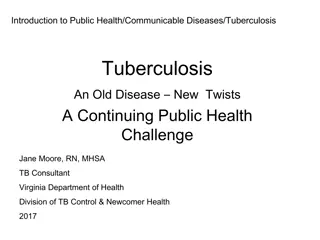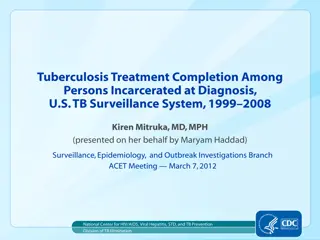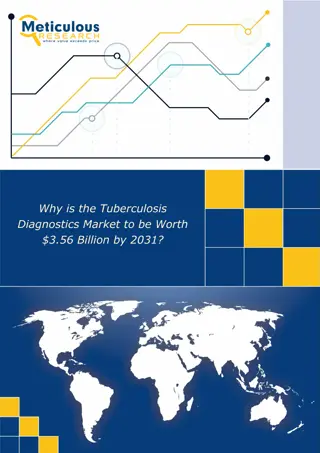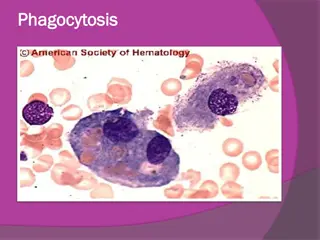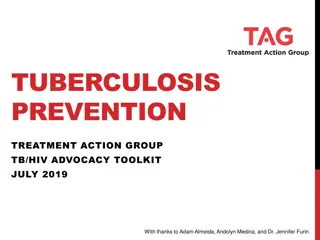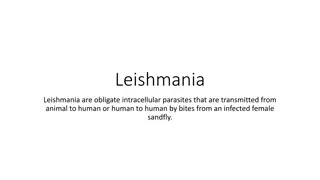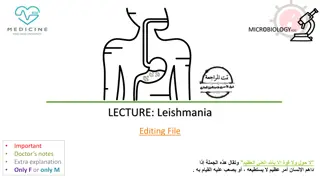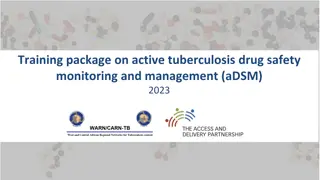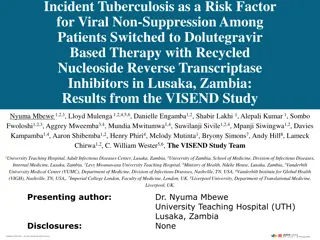Tuberculosis
The different types of tuberculosis, its clinical manifestations, pathophysiology, and how it spreads. Discover the signs and symptoms, diagnostic methods, and available treatment options for tuberculosis.
5 views • 23 slides
Mycobacterium Tuberculosis
Tuberculosis is a chronic disease caused by Mycobacterium tuberculosis that primarily affects the respiratory system. This overview covers the epidemiology, transmission methods, causative agents, pathogenesis, diagnostic methods, management, prevention, and control of tuberculosis. The importance o
2 views • 35 slides
Chest Imaging Interpretation for Tuberculosis Screening
Chest imaging plays a crucial role in screening for pulmonary tuberculosis (TB). This activity, led by Dana Kissner from Wayne State University Detroit Tuberculosis Clinic, focuses on interpreting chest imaging results to aid in the diagnosis and management of TB cases. The content includes informat
3 views • 22 slides
Effectiveness of Video Observed Therapy in Tuberculosis Management
Tuberculosis (TB) remains a global health challenge with issues of treatment compliance, cost, and distance to healthcare facilities. A study comparing Video Observed Therapy (VOT) with traditional Directly Observed Treatment Short Course (DOTS) in TB management is conducted to improve compliance, r
1 views • 17 slides
Progress and Initiatives of National Tuberculosis Program in Nepal
The National Tuberculosis Program in Nepal has achieved significant milestones since its inception, including the adoption of strategic initiatives like the Stop TB Strategy and the implementation of DOTS. Various national and international commitments have been made towards ending TB, with a focus
0 views • 46 slides
Active Tuberculosis Drug Safety Monitoring and Management Training Package 2023
This training package focuses on the safety monitoring and management of active tuberculosis drugs, specifically emphasizing causality assessment in determining adverse reactions. Participants will learn about assessing the likelihood of TB medicines causing adverse events, attributing relationships
3 views • 17 slides
Cutaneous Manifestations of Systemic Diseases: Endocrine Disorders and Diabetes Mellitus
Explore the cutaneous manifestations of systemic diseases, particularly focusing on endocrine disorders like diabetes mellitus. Learn about the dermatologic signs associated with conditions such as hypothyroidism, hyperthyroidism, Addison's disease, and Cushing syndrome. Discover specific manifestat
0 views • 88 slides
Bovine Tuberculosis: A Zoonotic Disease Impacting Humans and Animals
Bovine tuberculosis is a chronic bacterial disease affecting cattle and other mammals, with potential transmission to humans. Endemic in developing countries, it poses public health risks. Modes of transmission, clinical symptoms, diagnosis, and control measures are discussed, highlighting the impor
0 views • 22 slides
Understanding Cutaneous Circulation and Blood Supply in Different Body Regions
Cutaneous circulation plays a vital role in supplying blood to the skin, with variations in apical and non-apical regions of the body. The blood flow is regulated by neural, thermal, and metabolic factors, and controlled by sympathetic fibers. Sympathetic vasoconstriction and vasodilation affect the
0 views • 19 slides
Advancements in Tuberculosis Vaccine Development
Explore the importance of developing TB challenge models for vaccine selection, citing challenges such as the long duration and potential toxicity of current treatments. The need for effective vaccines is urgent due to high global TB incidence and mortality rates. Research focuses on human mycobacte
0 views • 19 slides
Overview of Cutaneous Tuberculosis: Causes, Classification, and Clinical Features
Cutaneous tuberculosis is caused by Mycobacterium tuberculosis and its manifestations depend on the host's immunity, route of entry, and bacterial load. It is classified into exogeneous and endogenous sources, with various types such as tuberculides and tuberculous chancre. Clinical features include
0 views • 31 slides
Overview of Antitubercular Drugs: Introduction, Classification, and Applications
Tuberculosis is a chronic granulomatous disease caused by Mycobacterium bovis in ruminants and Mycobacterium avium in dogs and pigs. These bacteria have a unique waxy appearance due to their cell wall composition, providing a shield against pharmacological compounds. Antitubercular drugs play a cruc
3 views • 28 slides
Understanding Tuberculosis of Hip and Knee Joint Deformities
Tuberculosis can affect the hip and knee joints, leading to various deformities and complications if left untreated. Common sites of TB in knee joint, neglected cases due to hamstring contracture, path mechanics of deformity development, along with differential diagnoses and treatment options are di
0 views • 8 slides
Understanding Mycobacterium: Causes and Impact of Tuberculosis
Mycobacterium is a genus of Actinobacteria known for causing serious diseases in mammals, including tuberculosis (TB) and leprosy. Tuberculosis, caused mainly by Mycobacterium tuberculosis, is a chronic infection that affects the lungs and various organs, especially prominent in developing regions d
0 views • 25 slides
Tuberculosis Diagnostics Market
Projecting a $3.56 billion valuation by 2031, the Tuberculosis Diagnostics Market will grow at a 5% CAGR from 2024. Key factors driving this expansion include rising TB incidence in less affluent countries, drug-resistant TB strains, and supportive d
0 views • 3 slides
Tuberculosis Data and Impact Assessment Update - September 13, 2023
Update on Tuberculosis Data, Impact Assessment, and Communications Hub (TB.DIAH) including key indicators such as TB detection rates, childhood TB notifications, treatment success rates, and more. The report highlights important aspects of TB control and monitoring progress across USAID's priority c
0 views • 5 slides
Complications and Presentations of Tuberculosis: A Detailed Overview by Dr. Ruchi Dua
This presentation by Dr. Ruchi Dua, Associate Professor at Aiims Rishikesh, delves into the complications of tuberculosis including local and systemic effects, as well as various presentations of extrapulmonary TB. Topics covered include common complications like respiratory failure, pleural effusio
0 views • 36 slides
Active Tuberculosis Drug Safety Monitoring & Management Training Package 2023
This training package focuses on the implementation of active tuberculosis drug safety monitoring and management (aDSM) in 2023. It covers the role of national and international partners, learning objectives, key steps in aDSM implementation, creating a national coordinating mechanism, developing a
0 views • 14 slides
Comprehensive Guide on Active Tuberculosis Drug Safety Monitoring and Management (aDSM) Implementation
This comprehensive guide provides key steps and timelines for implementing Active Tuberculosis Drug Safety Monitoring and Management (aDSM). It covers the development of a plan, defining roles and responsibilities, data collection, training, and electronic data consolidation. The timeline includes a
0 views • 20 slides
Building Capacity for Active Tuberculosis Drug Safety Monitoring and Management
This training package focuses on developing capacity for signal detection and causality assessment in the management of active tuberculosis drug safety. Key steps include creating a national coordinating mechanism, defining roles and responsibilities, training staff, and consolidating data electroni
0 views • 12 slides
Comprehensive Training Package on Active Tuberculosis Drug Safety Monitoring and Management (aDSM) 2023
This training package focuses on signal detection in active tuberculosis drug safety monitoring. It covers the main aims and principles of signal detection, completion of safety profiles for new TB drugs and regimens, definition of signal, continuous reporting activities, construction of risk profil
5 views • 15 slides
Understanding Tuberculosis: A Comprehensive Overview of the Disease
Tuberculosis, a chronic disease affecting both humans and animals, is caused by pathogenic Mycobacterium spp. This article covers the etiology, synonyms, history, and geographic distribution of tuberculosis, along with key terms like anthropozoonosis and zooanthroponosis. Learn about the tubercle ba
0 views • 24 slides
Guidelines for Tuberculosis Screening and Reporting in Chapter 89 Designated Facilities
Guidelines outlined in Chapter 89 for designated facilities in Texas include screening requirements, common terminology, reporting procedures, and conversion scenarios for tuberculosis testing. The definition of a Chapter 89-designated facility, screening guidelines, and reporting requirements are c
1 views • 18 slides
Update on Health Statistics in Samoa
The health statistics in Samoa reveal challenges and progress in managing HIV, syphilis, and tuberculosis cases. As of 2021, there are 13 people living with HIV in Samoa, with an increase in syphilis cases compared to the previous year. The country has seen no patients with multi-drug-resistant tube
0 views • 20 slides
Understanding Cutaneous Manifestations of HIV and AIDS
Human Immunodeficiency Virus (HIV) is a lentivirus that infects CD4 T lymphocytes, leading to Acquired Immunodeficiency Syndrome (AIDS). Cutaneous manifestations of HIV/AIDS vary depending on the stage of infection and CD4 T cell counts. Early signs include exanthem, oral hairy leukoplakia, candidia
0 views • 17 slides
Innovative Method for Portraying Cutaneous Diseases by Body Area Involvement Percentage
A unique approach utilizing a custom map creator to visually represent cutaneous diseases based on body area involvement percentage. The process involves manual tracing of body areas on custom maps created efficiently to provide a color-coordinated heatmap presentation. This method, developed at The
0 views • 6 slides
Evolution of Tuberculosis: From Ancient Origins to Modern Challenges
Tuberculosis, an ancient disease possibly acquired from domesticated animals thousands of years ago, has transitioned from endemic to epidemic in human populations. The causative agent, M. tuberculosis, was identified by Robert Koch in 1882. Over the years, public health efforts, improved nutrition,
0 views • 34 slides
Tuberculosis Treatment Completion Among Incarcerated Persons in the U.S. (1999-2008)
Tuberculosis treatment completion among incarcerated individuals is crucial for TB control, with incomplete treatment leading to increased risks. The national target for treatment completion within 12 months stands at 93%. Overall, the completion rate improved but falls short of this goal, with vari
0 views • 18 slides
Tuberculosis Diagnostics Market
The Tuberculosis Diagnostics Market is on track to achieve a value of $3.56 billion by 2031, fueled by a 5% CAGR from 2024. Explore the market's significant growth drivers and stay ahead of the curve by understanding future trends in TB diagnostics.\
0 views • 4 slides
Public Health and Tuberculosis: A Focus on XDR-TB in Howard County, Maryland
The evolving role of public health in addressing tuberculosis, specifically extensively drug-resistant tuberculosis (XDR-TB), in Howard County, Maryland is highlighted in this presentation. The county's demographics, TB cases over the years, and a pediatric XDR-TB case are discussed, emphasizing the
1 views • 22 slides
Understanding Phagocytosis, Inflammation, and Granulomas in Tuberculosis
Phagocytosis is a crucial process where cells engulf and digest pathogens. Inflammation responses involve various immune cells like neutrophils, plasma cells, lymphocytes, and macrophages. Granulomas, typical in diseases like tuberculosis, are mass accumulations in chronic inflammation. Tuberculosis
0 views • 18 slides
Understanding Tuberculosis Prevention and Vaccination
Learn about the fundamentals of tuberculosis prevention, the types of vaccines available, and current vaccines like Bacille Calmette-Guérin (BCG). Discover the limitations of the BCG vaccine and target populations for vaccination to combat tuberculosis effectively.
0 views • 25 slides
Understanding Leishmaniasis: Transmission, Symptoms, and Epidemiology
Leishmaniasis, caused by obligate intracellular parasites transmitted through infected sandfly bites, has different forms including cutaneous, mucocutaneous, and visceral. The life cycle involves promastigote and amastigote stages. Epidemiologically, it is a zoonosis with natural reservoirs and can
0 views • 14 slides
Understanding Leishmaniasis: Types, Symptoms, and Treatment Options
Leishmaniasis is a parasitic disease caused by Leishmania parasites transmitted through infected sand flies. It comes in three forms - cutaneous, mucocutaneous, and visceral - each with distinct characteristics and treatment approaches. Cutaneous leishmaniasis causes skin ulcers, mucocutaneous affec
0 views • 32 slides
Understanding Leishmania: Parasites and Diseases Overview
Discover the three main forms of Leishmaniassis caused by different species, the clinical types of cutaneous leishmaniasis, and the life cycle of Leishmania parasites. Learn about the transmission, manifestations, and types of this disease, including cutaneous and visceral leishmaniasis.
0 views • 12 slides
Training Package on Active Tuberculosis Drug Safety Monitoring and Management (aDSM) 2023
This presentation focuses on organizing the training of key staff to collect data for active tuberculosis drug safety monitoring. It covers the proper use of standard forms and treatment cards to ensure systematic and efficient data collection, along with reporting procedures for adverse events. Par
0 views • 21 slides
Understanding Tuberculosis: Causes, Symptoms, and Prevention Measures
Tuberculosis (TB) is caused by Mycobacterium tuberculosis bacteria and primarily affects the lungs but can impact other body parts. TB can be latent or active, with symptoms like fever, weight loss, and coughing. Prevention involves protective strategies during autopsies and universal precautions. E
0 views • 10 slides
Comprehensive Training Package on Active Tuberculosis Drug Safety Monitoring and Management (aDSM) 2023
This comprehensive training package focuses on active tuberculosis drug safety monitoring and management (aDSM) in 2023. It covers indicators, learning objectives, and essential information for implementing effective drug safety measures in tuberculosis treatment. The presentation emphasizes definin
0 views • 11 slides
Multi-class Skin Lesion Segmentation for Cutaneous T-cell Lymphomas
This research focuses on developing a multi-class skin lesion segmentation method specifically for Cutaneous T-cell Lymphomas using high-resolution clinical images. The study introduces a new dataset, a novel method called Multi-Knowledge Learning Network (MKLN), and achieves state-of-the-art result
0 views • 15 slides
Tuberculosis as a Risk Factor for Viral Non-Suppression in Patients Switched to Dolutegravir-Based Therapy
The study investigates the impact of incident tuberculosis on viral non-suppression among patients transitioning to Dolutegravir-based therapy in Zambia. It aims to identify factors associated with viral non-suppression and describe clinical outcomes in the context of tuberculosis occurrence. The re
0 views • 13 slides
